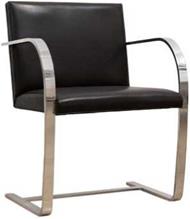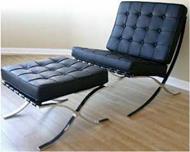In the 1920s, the fame of the Weimar school of design, architecture and Bauhaus applied arts grew at a rapid pace, which was founded by Walter Gropius (1883— 1970) in 1919 and moved to Dessau in 1925. Above all, the use of metal in the production of series furniture was a revolutionary move in the industry.
Metal met the criteria of modernity perfectly: it was a material that derived from industrial production, it had a distinctive appearance and uniform structure, and it could also be used in furniture of any sizes.
Innovation, however, did not consist in replacing one material with another. As Marcel Breuer (1902-1981) wrote, a Professor at Bauhaus in Dessau, metal marked the complete revision of hitherto concept of interior design: Metal furniture is one of the ingredients of a modern facility. It has no style, because no one expects that it will express anything other than its function and structure. The modern interior should not be a self-portrait of the architect, who designed it, nor bear any features of the inhabitants. The piece of furniture must allow air to pass through, it cannot impede movements or obscure the view of the room. I chose metal exactly for these requirements of modern spatial planning. Despite its low mass, steel, and aluminum even more so, is able to support great pressure. The lightweight structure increases the flexibility of the piece of furniture. All models are based on standardized components, which one can freely move and exchange. Metal furniture is to act as a useful device in everyday life. Modernity, understood as conforming a
Fig. 1.51 Chair designed by Ludwig Mies van der Rohe
 piece of furniture to the requirements of functionality, the lack of ornamentation, the use of new technologies and materials, as well as mechanised manufacturing processes, has become the overriding aim of Bauhaus designers. For example, the designs of Gropius or Josef Albers (1888-1976), precursory in their idea of the freedom of disassembly, confirm this thesis.
piece of furniture to the requirements of functionality, the lack of ornamentation, the use of new technologies and materials, as well as mechanised manufacturing processes, has become the overriding aim of Bauhaus designers. For example, the designs of Gropius or Josef Albers (1888-1976), precursory in their idea of the freedom of disassembly, confirm this thesis.
However, the most significant architect creating within the circle of the school was Ludwig Mies van der Rohe (1886-1972), a supporter of modernity based on pure form, functionality and sophisticated aesthetics. It was not until 1930 that he arrived at Dessau, though his architectural concepts coincide with the school’s programme already much earlier.
In 1927, Ludwig Mies van der Rohe created a series of his most interesting and most beautiful steel furniture, today considered classic. We owe the famous freely bending pipe chair to him (Fig. 1.51). It consisted of one segment of bent steel pipes, a wooden backrest and seat.
The famous Barcelona armchair (Fig. 1.52) should be mentioned here, built from a cubic skeleton of chrome-plated steel, which finish required precise manual work and leather cushions. With this project, van der Rohe demonstrated that modern
 Fig. 1.52 Barcelona armchair, designed by Ludwig Mies van der Rohe
Fig. 1.52 Barcelona armchair, designed by Ludwig Mies van der Rohe
aesthetics, despite rigorous simplicity, allows one to create objects of undeniable beauty. Using them in today’s design (Knoll International) proves that their beauty is everlasting.



